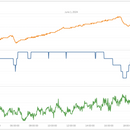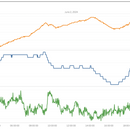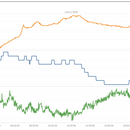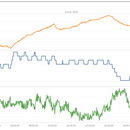Help making sense of humidity data for new house
Hey all. I’ve been analyzing temp and humidity data for our new home and am a bit stumped by a pattern I’m seeing. Was hoping someone here might have a hypothesis as to what’s going on…
We finished contstruction on our PGH and moved in back in November. House details:
* Climate Zone 4A/3A (Middle TN/Nashville)
* 2 story, 3400 sq ft
* HVAC system for each floor — 2 ton Mitsubishi PUZ/PVA
* Upper floor has supply-only fresh air connected to HVAC (Aprilaire 8145). Set to run 32min/hr at 96cfm (that’s the measured value the installers input)
* 2×6 exterior construction, R21 walls, R49 ceiling
* Encapsulated crawl space with dehumidifier (set to ~50%RH)
* Duct leakage tests were done upon completion (can dig up values but no issues here). Blower door test was not done.
* House is kept 70deg both upstairs and downstairs, except overnight upstairs turns down to 68deg (8pm-6am)
I have an Aranet4 monitor on each floor and have been looking at the data more closely since humidity has been running high the past few weeks. Upstairs I’m seeing 60-70% RH. Downstairs is 55-60%.
I am kind of assuming the higher RH levels are inevitable due to the time of year — it’s 80deg and 70% humidity outside right now. I did purchase a portable (50pint) dehumidifier last week I’ve been running upstairs to help keep humidity in check. It’s certainly pulling water out of the air, but not really moving the needle overall.
Looking at the data for the upstairs monitor (each attached image is one day of data, from midnight-midnight…sorry, GBA appears to auto-resize them), one things stands out to me — the cooling cycle on the HVAC definitely lowers the humidity, but it looks like as soon as it stops, the humidity jumps right back up. Is that expected? Presumably this moisture is coming either from the fresh air being brought in, or it’s just re-introducing the moisture that condensed on the coils during cooling?
Overall, trying to assess if something’s not running correctly at this point. Would appreciate any insight, and happy to provide more data.
GBA Detail Library
A collection of one thousand construction details organized by climate and house part













Replies
You are introducing a bit of moisture with your supply only air. My calculation with your given numbers, if you wanted a 70 degree at 50% humidity inside, you would need to remove .79 liters of water per hour. That’s not taking into account interior moisture.
That being said I think that works out to about 40 pints a day, which seems like the dehumidifier and ac should handle. Though with the addition of interior humidity maybe it is having trouble.
How I got there: total water content outside(g/cuft)- ideal water content inside(g/cuft)* cfm per hour
Assumption 820 liters/kg air
Thanks for running the numbers. I agree that if they're right I'd expect the HVAC + dehumidifier to keep up. It's just two adults, a dog, and 9 baby chicks in the house at the moment :)
I feel like I should be able to figure out the math, but can you show more of your work going from temp/relative humidity to the excess volume of water? I'm clearly missing something trying to work through it on my own.
Calculate total water content of air at specific temp and humidity via https://www.lenntech.com/calculators/humidity/relative-humidity.htm
subtract the desired inside from actual outside
convert air weight to volume with an assumed density, I used about 1.2 kg/m^3
multiply grams per hourly volume.
the rest is just units
Thank you!
hey gba how about you stop moderating my replies
Before you get to upset remember this is a new construction home. While the wood framing was kiln dried on the surface it still holds a lot of moisture that will escape over the first 24 months. The same for the concrete drywall and almost everything else has some moisture to release. Needing to run a dehumidifier for the first year would be pretty normal.
Consider turning off the AC downstairs making the upstairs unit do all the work and run continuously set in the “dry mode” allowing it to remove more moisture. The cool air will tend to find its way downstairs.
If your goal is summer time indoor humidity under 50% I think that is unrealistic for a system without reheat. The air exiting your Ductwork will be about 20° cooler than the room temp but it is also very near 100% humidity. In most climates the math says it is impossible to get the humidity to 50% by adding more cool but 100% RH air to the room.
Some thermostats try to control for summer humidity, by over cooling below the temperature set point by a few degrees and then letting the room warm back up to the set point. This can be affective if you can stand the room getting 3° bellow the set point sometimes.
Walta
Thanks Walta.
Not looking to have the house at 70deg 50% RH. Honestly I'd just love to keep it under 60% if I can. It's comfortable in the house, just want to keep things from growing and keep my allergies from getting aggrivated.
Totally understand the house still needs to 'dry'. That's one of the reasons I mentioned moving in 6 months ago...it's at least had some time to settle in, but didn't realize it may take 12-24 months.
I'll try raising the setpoint downstairs to make the upstairs system do most/all of the work and see if that leads to a better result. I'm still curious though -- the trend of the humidity quickly ticking back up after the A/C turns off -- is that expected/normal? Perhaps that's just the cumulative effect of the humidity from the outside air working back up to an equilibrium point...I need to establish a solid baseline of data then turn off the fresh air for a day or two to see if I can make sense of the role it's playing.
Appreciate the insights!
Also should mention -- the HVAC installers didn't enable 'dry mode'. I'll have to look at the installation manual to see if that's an easy addition or if I need to call them out to make that avaiable.
Maybe urban legend but I though 55% RH was the usual target figure that would keep houses well away from moisture problems? Is there a need to go down to 50%?
Yes, in cold climates it is necessary to keep the winter time indoor humidity below 55% to avoid having liquid moisture condense in the walls, if things will get wet and mold and rot are likely to follow.
In the cooling season keeping the indoor humidity below 55% is all but impossible in hot & humid climates.
Walta
Being a mini split with a variable speed compressor and blower the unit should not be cycling off very often unless the current load is less than the minimum capacity of the unit.
What do you have for a thermostat?
Walta
MKH2 thermostats for both systems, reading temp and humidity at the t-stat.
The humidity reads high on both of them, though I just set up the offsets to 'read' correctly and roughly match the Aranet devices which both read the same.
I know the turndown on the P series is less than the S series. Looks like the cooling capacity of the PUZ-A24NHA7 is 10,000 – 24,000 btu/h. So only 42% turndown (the 2 ton seems to have the worst ratio of the series).
All I can say is the only mini splits I read owners complaining about the units lack of modulation are always Mitsubishi with KUMO thermostats or other brands of 3X oversized multi splits.
Is the thermostat connected to the cloud?
Walta
No, thermostat is not connected to the 'cloud' in any way. Just a direct link to the HVAC system.
My new apartment above my new garage also has high humidity. We have some spray foam ceilings and some rockwool walls with a vapor barrier on the rockwool. 2.9 ACH with no ERV.
The Mitsubishi thermostats (I've had two!) read artificially high humidity. The cheapo Walmart thermometer and the dehumidifier readings are about the same, so I'm assuming they are correct.
The dehumidifier does the trick, keeping the apartment at 50% Rh. Spring has lessened the amount of time it cycles on (plus open windows), plus we have been occupying the space for 7 months. When we're not here, the humidity levels are lower.
I'm hoping the new building is "drying out' and the need for the dehumidifier eventually goes away. My HVAC guy is convinced that will be the case. Fingers crossed.
"The Mitsubishi thermostats (I've had two!) read artificially high humidity"
Yes, that has been my experience as well. Luckily there's an advanced menu option to adjust the 'offset' applied for the displayed value. So, it still reads incorrectly, but the display on the thermostat can be set up to be accurate.
The reason the turndown is not great on the two ton PUZ unit is that it is essentially the same as the 2.5 with different software. Giveaway is the outdoor units are the same weight.
Couple of things to check. Is your unit set for fan off in cooling mode? The lack of turndown on the unit will be cycling a fair bit, if the fan is always on you'll get re-evaporation any built up water from coil when the unit cycles off. This is an option you can set in the installer menu on the thermostat.
Your Aprilaire is mostly likey interlocked with the air handler causing to also run the fan which causes similar issues. I would try to reduce the runtime on the Aprilaire or if possible disable the fan interlock during the cooling season.
You can also try reducing the external static pressure setting (again installer menu) which will let the fan run at lower speed. This improves the humidity removal at a slight hit in efficiency. Since the indoor unit is also the same as the 2.5 ton unit, a bit less flow won't hurt anything.
Thanks Akos. Didn't realize the 2 ton was the same unit as the 2.5, but what you say makes sense.
To answer your questions:
* "Fan off in cooling mode" -- presumably that is relation to what it does once the set temp is hit? Function #27 is "Fan Speed Thermo-Off Cooling" which seems to be the only setting close to what you describe/I've read in other posts. Is that the setting you're referencing? Options are "RC setting, Stop, and Extra Low". What would you suggest here?
* Yes, the Aprilaire is interlocked with the air handler to run the fan if the HVAC is not already running. That's an easy change to disable, but as you suggest I've also been working to reduce the runtime on the unit. Slowly adjusting it down and watching CO2 in the house to make sure we're still getting enough fresh air. (The calculation in the docs suggest running 45mins/hour. I've lowered it down to 32 so far).
That is the setting. Set it to OFF. This will turn off the fan once cooling is finished. Along with this change and disabling the fresh air interlock, it will stop the humidity spike when the cooling cycles off.
If you decrease the external static pressure setting, it will also improve SHR ratio so you'll get more humidity removal.
Thanks.
Turns out I was wrong on the fresh air unit -- it is not interlocked with the HVAC. So it sounds like I have four overall options here:
1) Disable continuous fan during the summer (turn fan off once set point is reached) to avoid re-introducing the moisture still on the coil
2) Lower the static pressure to remove more moisture as it passes over the coil at lower fan speed
3) Run in 'dry' mode (from the description it sounds like just a variation of #2)
4) Run a dehumidifier
Or I suppose there's option #5: move someplace less humid :)
I think do option 1 for sure plus 2 or 3 and 4 if you absolutely must do more.
Option 2 &3 are good but understand they are unlikely to get you below 50%.
Option 4 understand that a dehumidifier is mostly a heater and I would call that option reheating.
Walta